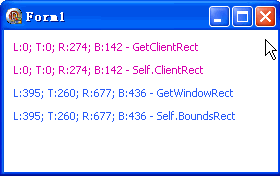獲取視窗矩形的四種方法: GetClientRect、ClientRect、GetWindowRect、BoundsRect
阿新 • • 發佈:2019-02-15
其中 GetClientRect、ClientRect 獲取的是視窗的客戶區矩形;
GetWindowRect、BoundsRect 是獲取視窗矩形;
另外, 還有一個 Windows.GetClientRect(使用方法同 GetWindowRect, 它們都是 API 函式),
這裡使用的 GetClientRect 是 Forms.GetClientRect.
本例效果圖:

GetWindowRect、BoundsRect 是獲取視窗矩形;
另外, 還有一個 Windows.GetClientRect(使用方法同 GetWindowRect, 它們都是 API 函式),
這裡使用的 GetClientRect 是 Forms.GetClientRect.
本例效果圖:

unit Unit1; interface uses Windows, Messages, SysUtils, Variants, Classes, Graphics, Controls, Forms, Dialogs, StdCtrls; typeTForm1 = class(TForm) procedure FormCreate(Sender: TObject); procedure FormPaint(Sender: TObject); procedure FormResize(Sender: TObject); end; var Form1: TForm1; implementation {$R *.dfm} procedure TForm1.FormCreate(Sender: TObject); begin Color := clWhite; end; procedure TForm1.FormPaint(Sender: TObject); conststr = 'L:%d; T:%d; R:%d; B:%d - '; var R1,R2,R3,R4: TRect; buf: array[Byte] of Char; x,y,h: Integer; begin R1 := GetClientRect; R2 := Self.ClientRect; GetWindowRect(Handle, R3); R4 := Self.BoundsRect; x := 10; y := 10; h := 10; Randomize; Canvas.Font.Color := Random($FFFFFF); wvsprintf(buf, str + 'GetClientRect', @R1); Canvas.TextOut(x, y, buf); y := y + h + Canvas.TextHeight(buf); wvsprintf(buf, str + 'Self.ClientRect', @R2); Canvas.TextOut(x, y, buf); y := y + h + Canvas.TextHeight(buf); Canvas.Font.Color := Random($FFFFFF); wvsprintf(buf, str + 'GetWindowRect', @R3); Canvas.TextOut(x, y, buf); y := y + h + Canvas.TextHeight(buf); wvsprintf(buf, str + 'Self.BoundsRect', @R4); Canvas.TextOut(x, y, buf); end; procedure TForm1.FormResize(Sender: TObject); begin Repaint; end; end.
